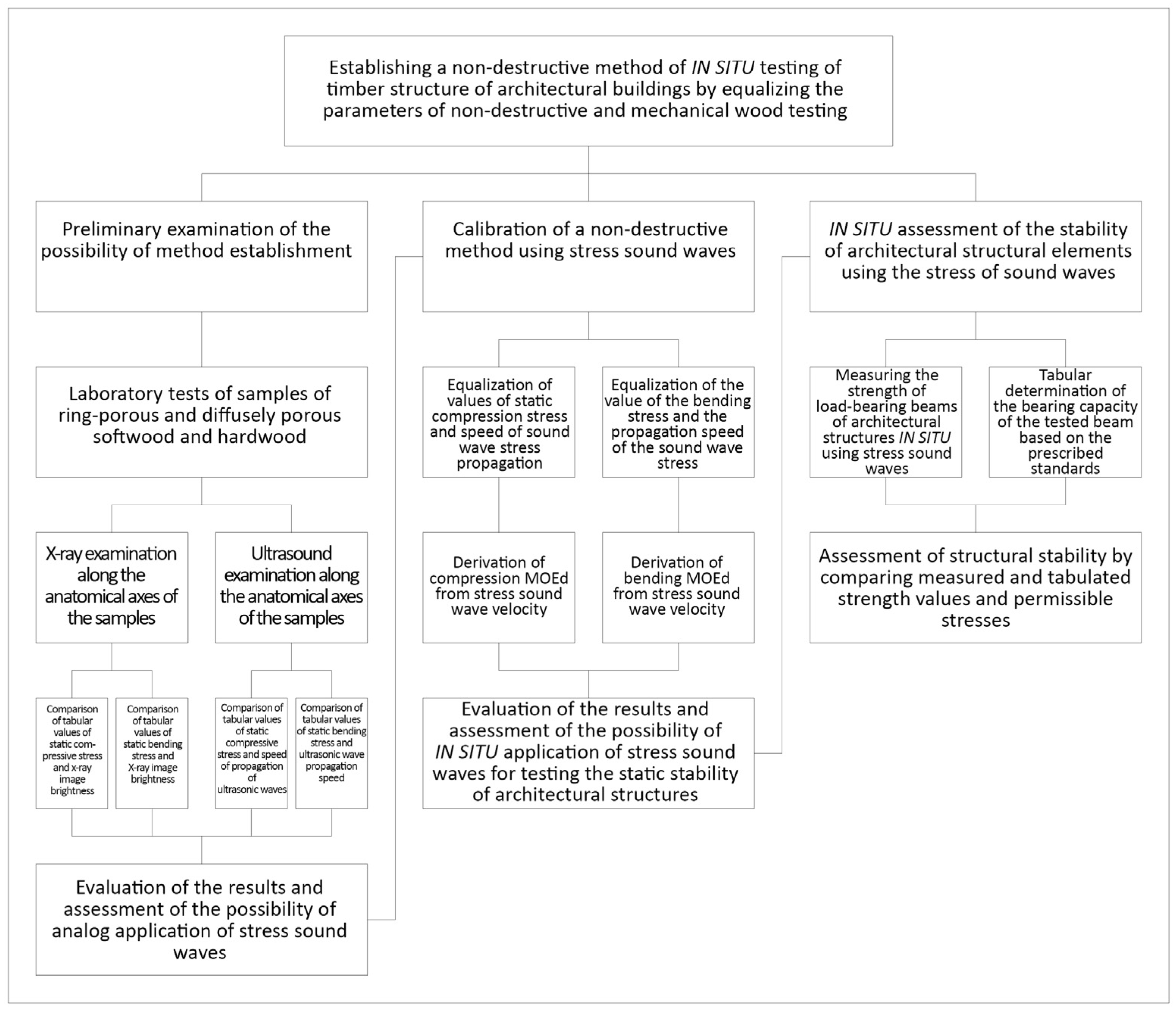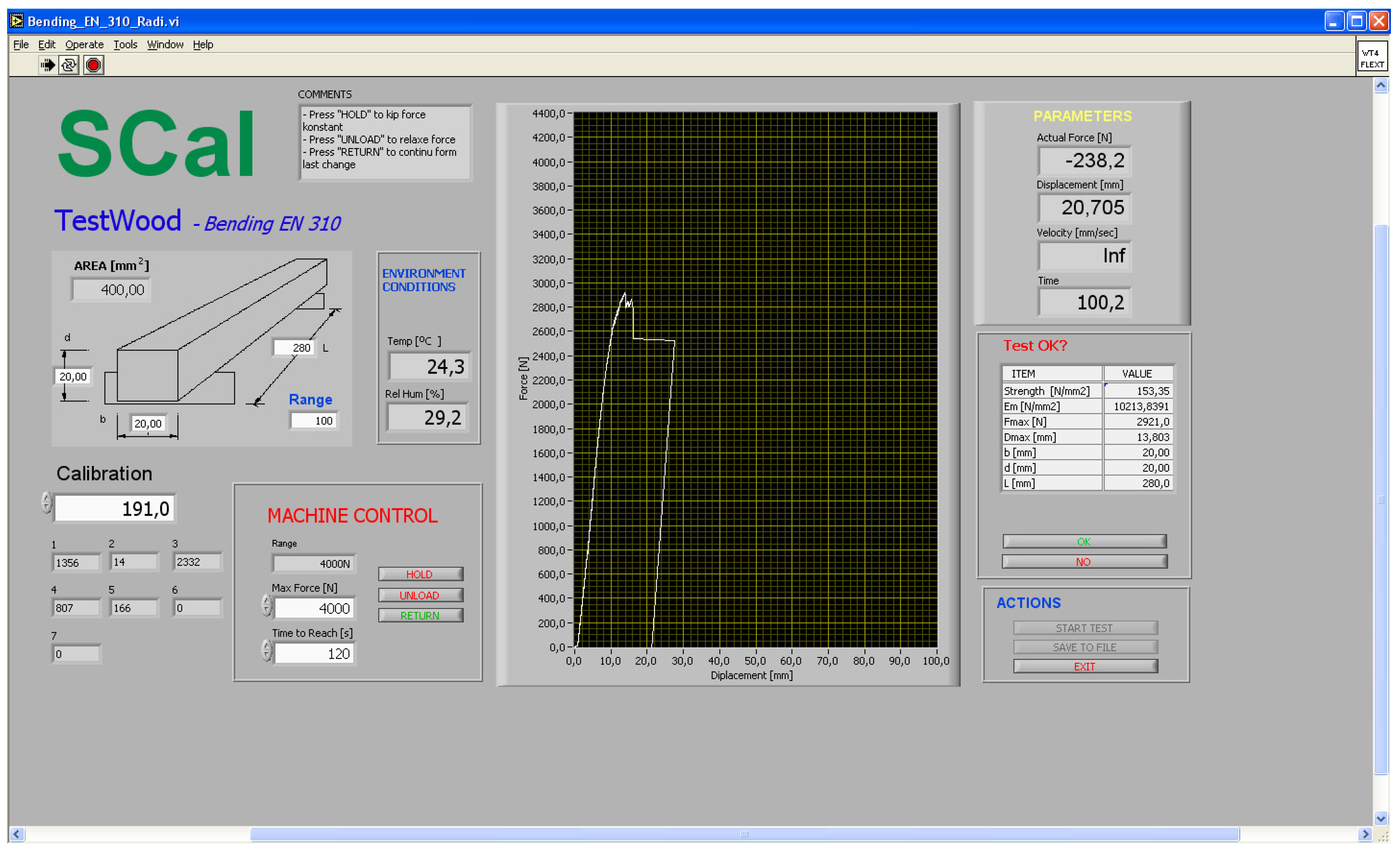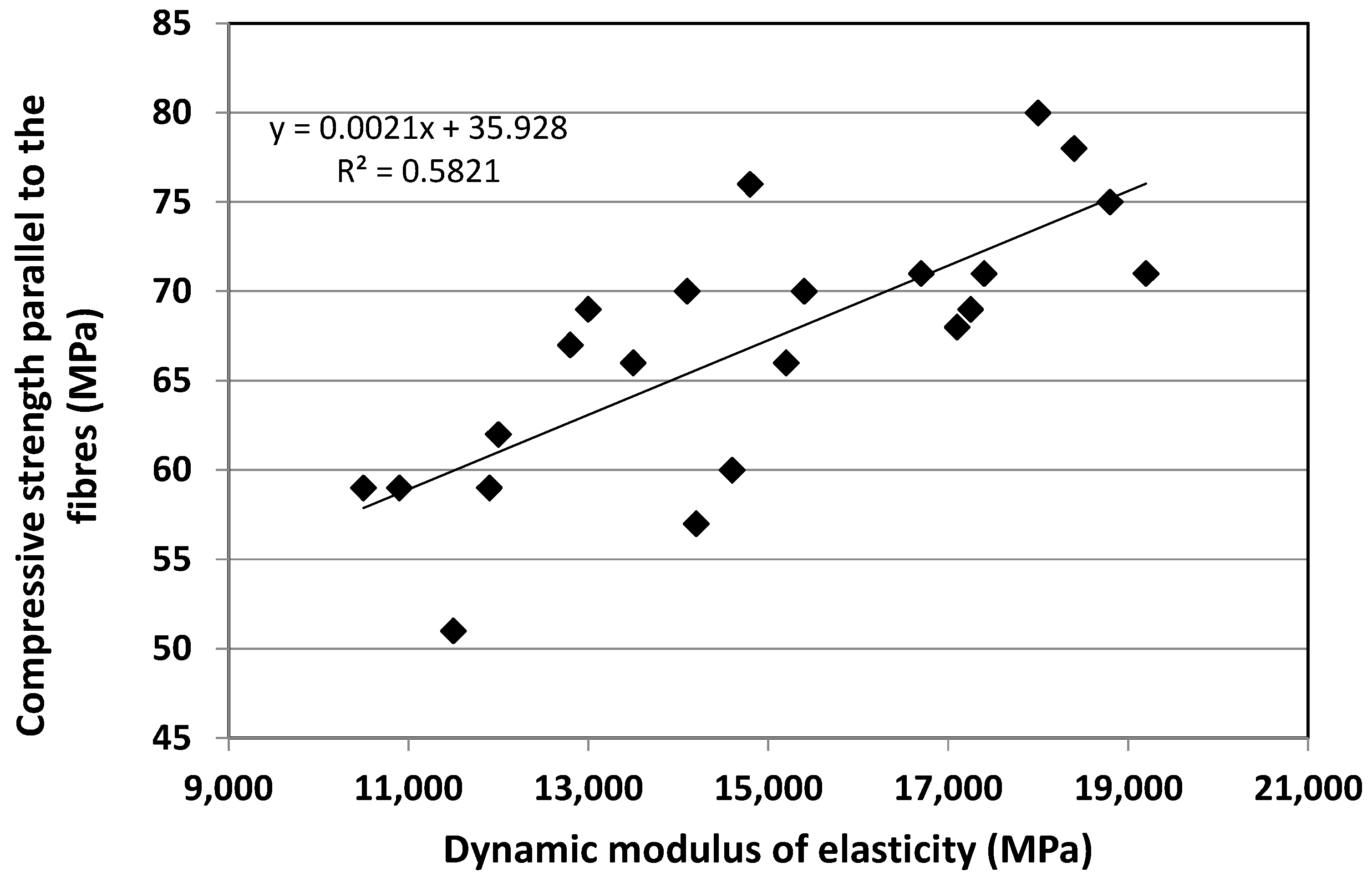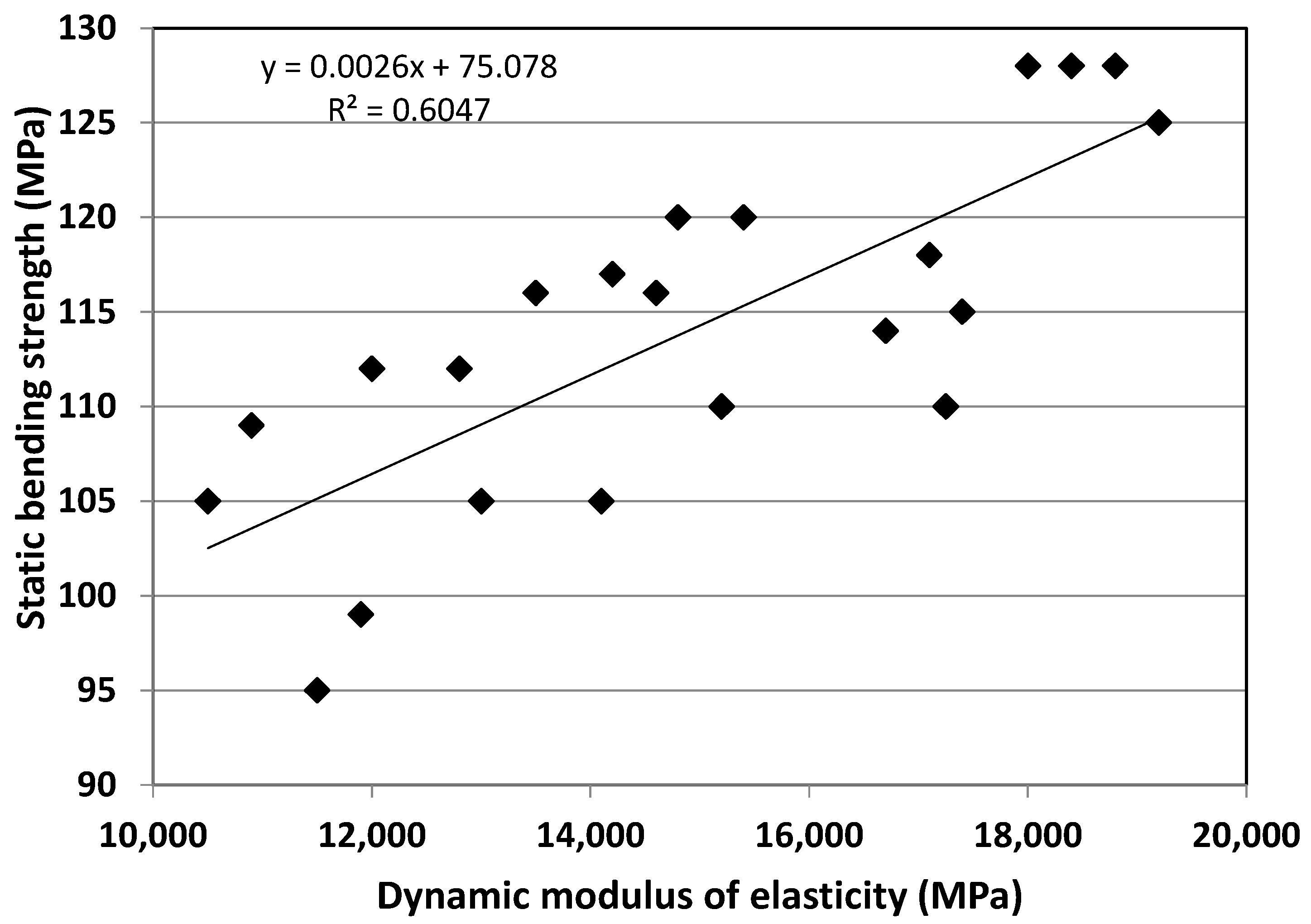An Approach to In Situ Evaluation of Timber Structures Based on Equalization of Non-Destructive and Mechanical Test Parameters
Abstract
:1. Introduction
- Visual Inspection (VI)—a method that involves a thorough visual examination of the timber to identify any visible defects or damage. VI can include using magnifying lenses, borescopes, endoscopes, and other specialized equipment to access hard-to-reach areas.
- Impact Echo Tests (IET)—a method that involves striking timber with a hammer and measuring the resulting vibrations. The data can be used to evaluate the thickness and stiffness of the wood, as well as identify any internal decay or insect damage.
- Drill Resistance Tests (DRT) involve drilling a small-diameter hole into the timber and measuring the resistance to drilling. DRT can be used to evaluate the internal condition of the wood, including density and moisture content, as well as identify any decay or insect damage.
- Infrared Thermography (IRT)—a method that uses infrared cameras to detect differences in temperature on a building’s surface. IRT can be used to identify areas of heat loss, air leakage, and moisture intrusion.
- Ultrasonic Tests (UT)—a method that uses high-frequency sound waves to detect cracks, voids, and other flaws in timber. UT can be used to evaluate the stiffness and density of the wood, as well as identify any internal decay or damage.
- X-ray Imaging—a method that uses X-rays to create an image of the internal structure of timber. X-ray imaging can be used to identify the presence of knots, cracks, and decay in the wood.
2. Methodologies
2.1. Preliminary Examination
2.2. Calibration of Non-Destructive Method
2.2.1. Determination of Wood Density
2.2.2. Determination of Wood Moisture Content (MC)
2.2.3. Determination of Compression and Bending Stresses
2.2.4. Stress-Sound Measurement Scheme and Equipment
2.2.5. Stress-Sound Measurement Implementation
2.2.6. Spectrogram
| No. of Samples | Type of Wood | Length [m] | No. of Selections | Time [µs] | Speed [m/s] | Thickness [mm] | Width [cm] | Mass [kg] | MC [%] | |
|---|---|---|---|---|---|---|---|---|---|---|
| Softwood | 1 | Spruce | 2.055 | 131 | 682.292 | 3012 | 47.29 | 20.2 | 8.39 | 10.3 |
| 1 | Fir | 1.9965 | 153 | 796.875 | 2505 | 46.44 | 23.9 | 8.96 | 9.6 | |
| 2 | Fir | 1.795 | 88 | 458.333 | 3916 | 47.29 | 20.1 | 7.99 | 9.6 | |
| 1 | Pine | 2.141 | 136 | 708.333 | 3022 | 49.44 | 23.9 | 14.38 | 7.9 | |
| 2 | Pine | 2.1225 | 161 | 838.542 | 2531 | 52.39 | 23.9 | 15.69 | 7.7 | |
| Hardwood | 1 | Oak | 2.04 | 108 | 562.500 | 3627 | 27.61 | 17.25 | 6.67 | 10.4 |
| 2 | Oak | 2.02 | 111 | 578.125 | 3494 | 26.81 | 21.25 | 9.03 | 9.8 | |
| 1 | Black locust | 1.543 | 103 | 536.458 | 2876 | 29.08 | 12.4 | 4.11 | 10 | |
| 2 | Black locust | 1.505 | 65 | 338.542 | 4445 | 28.42 | 10.6 | 3.49 | 9.3 | |
| 1 | Beech | 2.066 | 101 | 526.042 | 3927 | 51.03 | 15.6 | 12.46 | 7.3 | |
| 2 | Beech | 2.099 | 100 | 520.833 | 4030 | 50.09 | 16.1 | 11.96 | 6.4 |
| Damage | No. of Samples | TYPE OF WOOD | Length [m] | No. of Selections | Time [µs] | Speed [m/s] | Thickness [mm] | Width [cm] | Mass [kg] | MC [%] |
|---|---|---|---|---|---|---|---|---|---|---|
| 1 | 1 | Fir | 1.9965 | 141 | 734.375 | 2718 | 46.44 | 23.9 | 8.96 | 9.6 |
| 1 | 1 | Fir | 1.9965 | 90 | 468.750 | 4259 | 46.44 | 23.9 | 8.96 | 9.6 |
| 1 | 1 | Fir | 1.9965 | 94 | 489.583 | 4078 | 46.44 | 23.9 | 8.96 | 9.6 |
| 0 | 1 | Oak | 2.04 | 108 | 562.500 | 3627 | 27.61 | 17.25 | 6.67 | 10.4 |
| 1 | 1 | Oak | 2.04 | 115 | 598.958 | 3406 | 27.61 | 17.25 | 6.67 | 10.4 |
| 2 | 1 | Oak | 2.04 | 109 | 567.708 | 3593 | 27.61 | 17.25 | 6.67 | 10.4 |
| 1 + 1 | 1 | Oak | 2.02 | 110 | 572.917 | 3560 | 27.61 | 17.25 | 6.67 | 10.4 |
| 2 | 1 | Oak | 2.04 | 107 | 557.292 | 3660 | 27.61 | 17.25 | 6.67 | 10.4 |
| 3 | 1 | Oak | 2.04 | 108 | 562.500 | 3627 | 27.61 | 17.25 | 6.67 | 10.4 |
| 5 | 1 | Oak | 2.04 | 107 | 557.292 | 3660 | 27.61 | 17.25 | 6.67 | 10.4 |
| 5 | 1 | Oak | 2.04 | 117 | 609.375 | 3348 | 27.61 | 17.25 | 6.67 | 10.4 |
| 5 + 5 | 2 | Oak | 2.04 | 131 | 682.292 | 2990 | 27.61 | 17.25 | 6.67 | 10.4 |
2.2.7. Assessment of Timber Structural Elements
2.2.8. Comparative Analysis of Table and Measured Load Values
3. In Situ Measurement of the Strength of Timber Structural Elements
4. Discussion and Conclusions
Author Contributions
Funding
Data Availability Statement
Conflicts of Interest
Appendix A
| Permissible Stress | Solid Wood w = 18% | Glued Laminated Wood | ||||||||
|---|---|---|---|---|---|---|---|---|---|---|
| Stress Type | Label | Softwood | Oak, Beach | Softwood | Oak, Beach | |||||
| Class | Class | Class | Class | |||||||
| I | II | III | I | II | I | II | I | II | ||
| Bending | σmd | 1300 | 1000 | 700 | 1400 | 1200 | 1400 | 1100 | 1620 | 1370 |
| Tension | σt‖d | 1050 | 850 | 0 | 1150 | 1000 | 1050 | 850 | 1800 | 1080 |
| Compression | σc‖d | 1100 | 850 | 600 | 1200 | 1000 | 1100 | 850 | 1500 | 1200 |
| Compression perpendicular to fibers | σc┴d | 200 | 200 | 200 | 300 | 300 | 200 | 200 | 490 | 430 |
| 250 | 250 | 250 | 400 | 400 | 250 | 250 | ||||
| Shearing | τ‖d | 90 | 90 | 90 | 120 | 120 | 90 | 90 | 150 | 150 |
| Shearing from T forces | τm‖d | 90 | 90 | 90 | 120 | 120 | 120 | 120 | 130 | 110 |
| Fiber cutting | τ┴d | 350 | 300 | 250 | 400 | 350 | 350 | 300 | 250 | 400 |
References
- Avdelidis, N.P.; Moropoulou, A. Applications of Infrared Thermography for the Investigation of historic structures. J. Cult. Herit. 2004, 5, 119–127. [Google Scholar] [CrossRef]
- Baar, J.; Tippner, J.; Rademacher, P. Prediction of mechanical properties-modulus of rupture and modulus of elasticity-of five tropical species by nondestructive methods. Maderas. Cienc. Tecnol. 2015, 17, 239–252. [Google Scholar] [CrossRef]
- Bachtiar, E.V.; Sanabria, S.J.; Mittig, J.P.; Niemz, P. Moisture-dependent elastic characteristics of walnut and cherry wood by means of mechanical and ultrasonic test incorporating three different ultrasound data evaluation techniques. Wood Sci. Technol. 2017, 51, 47–67. [Google Scholar] [CrossRef]
- Bucur, V.; Böhnke, I. Factors affecting ultrasonic measurements in solid wood. Ultrasonics 1994, 32, 385–390. [Google Scholar] [CrossRef]
- Keunecke, D.; Sonderegger, W.; Pereteanu, K.; Lüthi, T.; Niemz, P. Determination of Young’s and shear moduli of common yew and Norway spruce by means of ultrasonic waves. Wood Sci. Technol. 2007, 41, 309–327. [Google Scholar] [CrossRef]
- Kandemir-Yucel, A.; Tavukcuoglu, A.; Caner-Saltik, E.N. In situ assessment of structural timber elements of a historic building by infrared thermography and ultrasonic velocity. Infrared Phys. Technol. 2007, 49, 243–248. [Google Scholar] [CrossRef]
- Hussain, A.; Akhtar, S. Review of Non-Destructive Tests for Evaluation of Historic Masonry and Concrete Structures. Arab. J. Sci. Eng. 2017, 42, 925–940. [Google Scholar] [CrossRef]
- Fais, S.; Casula, G.; Cuccuru, F.; Ligas, P.; Bianchi, M.G. An innovative methodology for the non-destructive diagnosis of architectural elements of ancient historical buildings. Sci. Rep. 2018, 8, 4334. [Google Scholar] [CrossRef]
- Barnaure, M.; Cincu, M. Testing methods for the assessment of material properties in historical masonry structures: A review. Proc. IOP Conf. Ser.: Mater. Sci. Eng. 2019, 662, 032040. [Google Scholar] [CrossRef]
- Tejedor, B.; Lucchi, E.; Bienvenido-Huertas, D.; Nardi, I. Non-destructive Techniques (NDT) for the Diagnosis of Heritage Buildings: Traditional Procedures and Future Perspectives. Energy Build. 2022, 236, 112029. [Google Scholar] [CrossRef]
- Paipetis, A.S.; Matikas, T.E.; Aggelis, D.G.; Van Hemelrijck, D. Emerging Technologies in Non-Destructive Testing V, 1st ed.; CRC Press: Boca Raton, FL, USA, 2012. [Google Scholar]
- Jokileto, J. Aspekti autentičnosti. GDKS 2002, 26, 11–16. [Google Scholar]
- Klapálek, P.; Melzerová, L. Methods of Non-Destructive Assessment of Timber. Appl. Mech. Mater. 2015, 732, 369–372. [Google Scholar] [CrossRef]
- Cruz, H.; Yeomans, D.; Tsakanika, E.; Macchioni, N.; Jorissen, A.; Touza, M.; Mannucci, M.; Lourenço, P.B. Guidelines for On-Site Assessment of Historic Timber Structures. Int. J. Archit. Herit. 2014, 9, 277–289. [Google Scholar] [CrossRef]
- Nowak, T.P.; Jasieńko, J.; Hamrol-Bielecka, K. In situ assessment of structural timber using the resistance drilling method—Evaluation of usefulness. Constr. Build. Mater. 2016, 102, 403–415. [Google Scholar] [CrossRef]
- Gomes, I.D.; Kondis, F.; Sousa, H.S.; Branco, J.M.; Lourenço, P.B. Assessment and Diagnosis of Two Collar Timber Trusses by Means of Visual Grading and Non-destructive Tests. In Historical Earthquake-Resistant Timber Framing in the Mediterranean Area. Lecture Notes in Civil Engineering; Cruz, H., Saporiti Machado, J., Campos Costa, A., Xavier Candeias, P., Ruggieri, N., Manuel Catarino, J., Eds.; Springer: Berlin/Heidelberg, Germany, 2016; Volume 1, pp. 311–320. [Google Scholar] [CrossRef]
- Stepinc, M.; Rajčić, V.; Barbalić, J. Inspection and Condition Assessment of Existing Timber Structures. Građevinar 2017, 69, 869–873. [Google Scholar] [CrossRef]
- De Matteis, G.; Ricci, L.; Chisari, C.; Mandara, A.; Panico, S. Structural Assessment of Historical Timber Roof Trusses: The Case of the Croce di Lucca Church in Naples. In Protection of Historical Constructions. PROHITECH 2021. Lecture Notes in Civil Engineering; Vayas, I., Mazzolani, F.M., Eds.; Springer: Berlin/Heidelberg, Germany, 2022; Volume 209, pp. 1111–1125. [Google Scholar]
- Wang, P.; Li, S.; Macchioni, N.; Palanti, S.; Milani, G. Comprehensive Evaluation Method of Historical Timber Structural Building Taking Fujiu Zhou House as an Example. Forests 2021, 12, 1172. [Google Scholar] [CrossRef]
- Cruz, C.; Gaju, M.; Gallego, A.; Rescalvo, F.; Suarez, E. Non-Destructive Multi-Feature Analysis of a Historic Wooden Floor. Buildings 2022, 12, 2193. [Google Scholar] [CrossRef]
- Martinez, I.; Martinez, E. Qualitative Timber Structure Assessment with Passive IR Thermography. Case Study of Source of Common Errors. Case Stud. Constr. Mater. 2022, 16, e00789. [Google Scholar] [CrossRef]
- Nasir, V.; Ayanleye, S.; Kazemirad, S.; Sassan, F.; Adamopoulos, S. Acoustic Emission Monitoring of Wood Materials and Timber Structures: A Critical Review. Build. Mater. 2022, 350, 12887. [Google Scholar] [CrossRef]
- Xin, Z.; Ke, D.; Zhang, H.; Yu, Y.; Liu, F. Non-destructive Evaluating the Density and Mechanical Properties of Ancient Timber Members Based on Machine Learning Approach. Build. Mater. 2022, 341, 127855. [Google Scholar] [CrossRef]
- Galligan, W.J.; Courteau, R.W. Measurement of Elasticity of Lumber with Longitudinal Stress Waves and the Piezoelectric Effect of Wood. In Proceedings of the 2nd International Symposium of Nondestructive Testing of Wood, National Science Foundation, Washington State University, Pullman, WA, USA, April 1965; pp. 223–224. [Google Scholar]
- Gerhards, C.C. Bending Creep and Load Duration of Douglas-Fir 2 by 4s under Constant Load. Wood. Fiber. Sci. 1991, 23, 384–409. [Google Scholar]
- Gojković, M.; Stojić, D. Drvene Konstrukcije; Grosknjiga, Građevinski Fakultet Univerziteta: Belgrade, Serbia, 1996. [Google Scholar]
- Sisojević, D. Anatomija Drveta; Šumarski fakultet, Institut za Preradu Drveta: Belgrade, Serbia, 1987. [Google Scholar]
- Šoškić, B.; Popović, Z. Svojstva Drveta; Šumarski Fakultet Univerziteta: Belgrade, Serbia, 2002. [Google Scholar]
- Josifovski, A.; Savanović, D. Non-destructive testing of wood structures by X-rays. SAJ 2017, 1, 51–64. [Google Scholar]
- Armstrong, L.D. Effects of Moisture Changes of Crep in Wood. Nature 1965, 185, 862–863. [Google Scholar] [CrossRef]
- SRPS EN 1995-1-1:2012; Eurocode 5: Design of Timber Structures—Part 1-1: General—Common Rules and Rules for Buildings. Institute for Standardization of Serbia: Belgrade, Serbia, 2016. Available online: https://iss.rs/en/ (accessed on 10 March 2023).
- EN 1991-1-1:2002; Eurocode 1: Actions on Structures—Part 1-1: General Actions—Densities, Self-Weight, Imposed Loads for Buildings. European Committee for Standardization: Brussels, Belgium, 2002. Available online: https://eurocodes.jrc.ec.europa.eu (accessed on 10 March 2023).
- Popović, Z. Uticaj Vlažnosti i Temperature na Modul Elastičnosti i Savitljivost Bukovog Drveta. Master’s Thesis, Šumarski Fakultet Univerziteta, Beograd, Serbia, 1990. [Google Scholar]
- Pentoney, R.E.; Davidson, R.W. Rheology and the study of wood. Forest. Pro. J. 1962, 12, 243–248. [Google Scholar]






| Softwood | Hardwood | ||||||||||
|---|---|---|---|---|---|---|---|---|---|---|---|
| Ring Porous | Diffuse Porous | ||||||||||
| Spruce 1 | Fir 1 | Fir 2 | Pine 1 | Pine 2 | Oak 1 | Oak 2 | Black Locust 1 | Black Locust 2 | Beech 1 | Beech 2 | |
| Axial [mm] | 30.19 | 28.94 | 28.81 | 29.24 | 28.66 | 28.94 | 29.32 | 29.18 | 28.08 | 29.42 | 29.35 |
| Radial [mm] | 19.77 | 19.82 | 19.75 | 20.05 | 19.99 | 19.93 | 19.92 | 19.74 | 20.12 | 19.95 | 19.75 |
| Tangential [mm] | 19.73 | 19.78 | 19.81 | 20 | 19.84 | 19.83 | 19.94 | 19.9 | 20.35 | 19.94 | 19.81 |
| Mass [g] | 5.64 | 4.72 | 4.82 | 7.84 | 6.45 | 7.73 | 9.55 | 8.55 | 8.67 | 9.1 | 8.02 |
| Axial [mm] | 30.08 | 28.92 | 28.81 | 29.18 | 28.58 | 28.94 | 29.24 | 29.14 | 28.03 | 29.35 | 29.28 |
| Radial [mm] | 19.33 | 19.39 | 19.36 | 19.61 | 19.77 | 19.65 | 19.68 | 19.37 | 19.72 | 19.66 | 19.49 |
| Tangential [mm] | 18.89 | 19.31 | 19.29 | 19.56 | 19.53 | 19.47 | 19.49 | 19.33 | 19.78 | 19.35 | 19.41 |
| Mass [g] | 4.92 | 4.33 | 4.42 | 7.19 | 5.91 | 7.08 | 8.81 | 7.86 | 8.02 | 8.4 | 7.41 |
| MC [%] | 10.9 | 9.0 | 9.0 | 9.0 | 9.1 | 9.2 | 8.4 | 8.8 | 8.1 | 8.3 | 8.2 |
| Oven-dry density [g/cm3] | 0.448 | 0.400 | 0.411 | 0.642 | 0.536 | 0.639 | 0.786 | 0.720 | 0.734 | 0.752 | 0.669 |
| Softwood | Hardwood | ||||||||||
|---|---|---|---|---|---|---|---|---|---|---|---|
| Ring Porous | Diffuse Porous | ||||||||||
| Spruce 1 | Fir 1 | Fir 2 | Pine 1 | Pine 2 | Oak 1 | Oak 2 | Black Locust1 | Black Locust2 | Beech 1 | Beech 2 | |
| Length (mm) | 39.72 | 40.2 | 39.13 | 39.37 | 39.1 | 39.04 | 39.3 | 39.32 | 39.3 | 39.48 | 39.57 |
| Width (mm) | 20.18 | 20.16 | 19.96 | 20.12 | 19.93 | 19.92 | 19.86 | 19.79 | 20.27 | 19.94 | 19.8 |
| Thickness | / | / | / | / | / | / | / | / | / | / | / |
| Compressive force—transversal (lateral) | 3113 | 1883 | 1648 | 13,129 | 4979 | 4149 | 4621 | 5839 | 4736 | 4624 | 4760 |
| Compressive force—axial (transverse) | / | / | / | / | / | / | / | / | / | / | / |
| Transversal stress | 3.9 | 2.3 | 2.1 | 16.6 | 6.4 | 5.3 | 5.9 | 7.5 | 5.9 | 5.9 | 6.0 |
| Axial stress | / | / | / | / | / | / | / | / | / | / | / |
| Length (mm) | / | / | / | / | / | / | / | / | / | / | / |
| Width (mm) | 19.75 | 10.86 | 19.94 | 20.08 | 20.29 | 19.84 | 19.84 | 19.93 | 20.02 | 19.82 | 19.96 |
| Thickness | 19.86 | 19.85 | 19.89 | 20.09 | 20.08 | 19.77 | 19.79 | 19.9 | 20.12 | 19.19 | 19.9 |
| Compressive force—transversal (lateral) | / | / | / | / | / | / | / | / | / | / | / |
| Compressive force—axial (transverse) | 19,550 | 2116 | 21,212 | 34,214 | 27,739 | 24,223 | 27,742 | 39,241 | 37,842 | 31,563 | 29,053 |
| Transversal stress | / | / | / | / | / | / | / | / | / | / | / |
| Axial stress | 49.8 | 53.7 | 53.5 | 84.8 | 60.0 | 61.8 | 70.7 | 98.9 | 93.9 | 80.5 | 73.1 |
| Softwood | Hardwood | ||||||||||
|---|---|---|---|---|---|---|---|---|---|---|---|
| Ring Porous | Diffuse Porous | ||||||||||
| Spruce 1 | Fir 1 | Fir 2 | Pine 1 | Pine 2 | Oak 1 | Oak 2 | Black Locust1 | Black Locust Acacia 2 | Beech 1 | Beech 2 | |
| h [mm] | 19.74 | 19.86 | 19.84 | 20.01 | 19.78 | 19.89 | 19.85 | 19.79 | 20.1 | 19.88 | 19.91 |
| b [mm] | 19.72 | 19.83 | 19.88 | 20.11 | 19.91 | 19.88 | 19.84 | 19.94 | 20.06 | 19.92 | 19.81 |
| Bending strength MPa [N/mm2] | 88.9 | 79.9 | 71.6 | 132.9 | 102.8 | 91.09 | 124.5 | 86.4 | 170.3 | 169.8 | 128 |
| Modulus of elasticity MPa [N/mm2] | 6108 | 8137 | 7905 | 11,567 | 7448 | 6792 | 8232 | 11,020 | 14,788 | 11,987 | 9145 |
| Force max. [N] | 1627 | 1488 | 1334 | 2572 | 1907 | 1706 | 2316 | 1605 | 3288 | 3182 | 2393 |
| Deflection max. [mm] | 13.85 | 11.78 | 10.28 | 9.39 | 17.95 | 16.58 | 15.04 | 10.27 | 14.5 | 12.64 | 16.67 |
| h [mm] | 19.74 | 19.83 | 19.89 | 19.98 | 20.03 | 19.85 | 19.94 | 19.9 | 10.07 | 19.9 | 19.8 |
| b [mm] | 19.78 | 19.79 | 19.86 | 19.92 | 20.14 | 19.83 | 19.85 | 19.92 | 20.31 | 19.84 | 19.8 |
| Bending strength MPa [N/mm2] | 84.1 | 81.3 | 76.9 | 152.1 | 119.1 | 103.3 | 105.8 | 200.9 | 185.2 | 135.9 | 133.3 |
| Modulus of elasticity MPa [N/mm2] | 8784 | 8262 | 7304 | 12,778 | 10,337 | 7722 | 6882 | 15,175 | 13,920 | 10,315 | 9722 |
| Force max. [N] | 1544 | 1506 | 1438 | 2880 | 2291 | 1921 | 1987 | 3773 | 3607 | 2542 | 2464 |
| Deflection max. [mm] | 12.58 | 11.26 | 11.06 | 18.21 | 12.6 | 17.36 | 20.05 | 13.16 | 14.74 | 11.61 | 12.59 |
Disclaimer/Publisher’s Note: The statements, opinions and data contained in all publications are solely those of the individual author(s) and contributor(s) and not of MDPI and/or the editor(s). MDPI and/or the editor(s) disclaim responsibility for any injury to people or property resulting from any ideas, methods, instructions or products referred to in the content. |
© 2023 by the authors. Licensee MDPI, Basel, Switzerland. This article is an open access article distributed under the terms and conditions of the Creative Commons Attribution (CC BY) license (https://creativecommons.org/licenses/by/4.0/).
Share and Cite
Josifovski, A.; Todorović, N.; Milošević, J.; Veizović, M.; Pantelić, F.; Aškrabić, M.; Vasov, M.; Rajčić, A. An Approach to In Situ Evaluation of Timber Structures Based on Equalization of Non-Destructive and Mechanical Test Parameters. Buildings 2023, 13, 1405. https://doi.org/10.3390/buildings13061405
Josifovski A, Todorović N, Milošević J, Veizović M, Pantelić F, Aškrabić M, Vasov M, Rajčić A. An Approach to In Situ Evaluation of Timber Structures Based on Equalization of Non-Destructive and Mechanical Test Parameters. Buildings. 2023; 13(6):1405. https://doi.org/10.3390/buildings13061405
Chicago/Turabian StyleJosifovski, Andrej, Nebojša Todorović, Jelena Milošević, Marko Veizović, Filip Pantelić, Marina Aškrabić, Miomir Vasov, and Aleksandar Rajčić. 2023. "An Approach to In Situ Evaluation of Timber Structures Based on Equalization of Non-Destructive and Mechanical Test Parameters" Buildings 13, no. 6: 1405. https://doi.org/10.3390/buildings13061405





